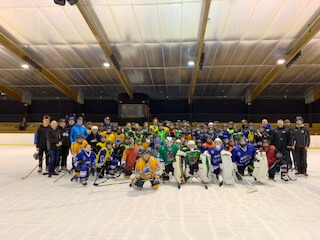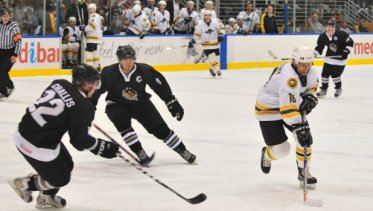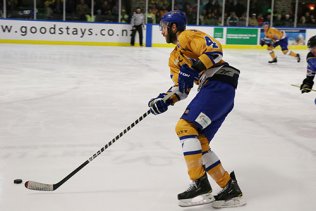
GETTING KIDS IN SKATES: WHAT EACH REGION ARE DOING TO GROW LEARN TO PLAY PROGRAMMES
The sporting landscape in New Zealand is becoming more and more diverse.
Kiwi kids are ditching the “non-traditional” sports in order to find unique and niche activities that are both fresh and challenging.
A recent study showed that basketball has quickly overtaken rugby as the number one high school sport in this country, and we’ve just found out that breakdancing may potentially make its way into the 2022 Olympics.
All of that has parents and kids on the look-out for something new to enjoy.
Enter hockey. And a great opportunity to slide in and show kids and parents how fun our sport can be and why we love it so much.
And that’s exactly how our regions are preparing, as more and more kids put their feet into skates and get out on the ice.
We decided to catch up with each region to see what they’re doing to get kids in skates, and keep them there, but also some of the challenges they face along the way.
AUCKLAND – Cam Stephens
Compared to other regions, Auckland has the distinct advantage of population size. They also have two rinks, making it easier for kids and parents to get ice time and coaching.
However, they still face many of the problems our other regions face.
Cam Stephens, who moved to New Zealand from Canada 18 months ago, is Auckland Ice Hockey’s director of hockey – responsible for overseeing player and coach development.
He got into coaching first as a golf pro, saying he was always interested in coaching kids. Then he had three boys of his own and it all progressed naturally.
Cam admits the benefits of having the biggest group of players and the biggest resource of coaches, but say’s they’ve also worked extremely hard to build a coaching base to help throughout the levels.
They have a large Learn-to-Play programme, as well as strong bantam and junior programmes. Then they have their U12, U15, and U18 representative teams.
“It’s in a stage where it’s a growing sport and we’re fortunate to be a part of that in Auckland,” Cam said.
“It’s been really neat coming from Canada where it’s obviously such an ingrained sport, to see this much ice hockey in New Zealand and in Auckland specifically.”
Auckland’s Learn to Play programme runs twice a week, plus weekend practices.
Their junior and bantam teams also practice twice a week and then have games.
“I’ve just been here a year and half and it certainly seems to me that it’s a growing sport,” he said.
“Auckland is definitely an area that has seen a lot of growth. The board has worked very hard over the past few years to really improve the organisation and make it a really good experience for kids and families.”
Despite the success, they still face a challenge in keeping the kids in the sport
“I think this is the challenge everywhere and that is the cost can be quite prohibitive,” he said.
“I know personally having all three boys playing, the cost is high especially with the equipment involved.
“If there was some way we could reduce the cost and make it more accessible to more families I think that would be a huge key for growing the sport.”
CANTERBURY – Dean Tonks
Dean Tonks is a name that many hockey fans will recognise, both from his days in Auckland, but also in Christchurch.
A UK man by birth, he moved over here eight years ago and most recently picked up a coaching role with Canterbury in 2015.
When he arrived, the club was not in the best condition, but you can sense the positivity in his voice, and the numbers show the club is on the up.
“Yeah it was in a pretty bad place at the time,” he said.
“After the earthquake, the numbers were rock bottom and the club wasn’t in a very good place. We started with basically nothing in our Learn-to-Play system and in terms of children under 12, we only had seven kids.
“Four years down the line, we have an Under-8 league with over 23 kids, then our U12 league we’ve got around 65-70 kids, then our U15 age group has grown and we’re sitting at about 38 kids and same with our midgets.”
Dean has also helped establish a high school league in order to keep more teenagers involved with the sport.
Unfortunately for the club, they’re almost at the tether of their resources when it comes to numbers. Great news for New Zealand Ice Hockey, but not such great news for the club, which is trying to work out “where-to next.”
“Last year we had a growth of 25% in anyone under 18,” Dean said.
“Now the numbers are where we are, we just don’t have any more ice time. We’re restricted with the one rink and we’re basically at full capacity across all age levels.
“Numbers-wise we can’t get any more kids in any of our sessions really. We’re in a really good position in that regard, but what we really need is a second rink which would then help us re-structure the whole club where we could look to have a primary school and senior league.”
The club obviously hasn’t grown on its own, and Dean has spent hours going into local schools and recruiting kids to come and give hockey a go.
They offer two free Learn to Play sessions which they hope helps encourage kids to pick up the sport full-time.
But, like Auckland, cost becomes a massive factor.
“One thing we all struggle with across the country is how much it costs to play,” he said.
“There’s only a small amount of kids that can afford it.”
Canterbury also loses a large amount of players to university. A number of juniors will head to Wellington, Dunedin, and Auckland for their tertiary studies, leaving behind the club in Christchurch.
Despite this, the club appears in great shape, and if Dean and his crew can keep the interest high, there might just be enough keen eyes looking in, who might also think building a second rink is a good idea.
QUEENSTOWN – Ant Rusky Jones
Ant Jones is one of two senior coaches in Queenstown, and like many coaches, it all started out as being a parent-helper.
Since then, Ant has been involved with coaching the junior Stampede and junior Thunder teams. He has two boys who play, but admits it’s not because of them that he coaches.
“To be honest, it’s more the fact that it’s such an awesome sport and I love seeing kids progress really”.
Like Canterbury, Queenstown has experienced some great growth in numbers, however they are suffering with limited resources.
“We’re really screaming out for ice time,” Ant said.
“Some of the other regions I know players are on the ice sometimes five times a week. Here, a lot of our juniors only get one session.
“We’ve had some really good growth as a club, but now we just need to maintain it and that’s the challenge.”
Their resurgence started around four years ago with the growth of the lower age groups. At the top end, they’ve struggled to retain players because other opportunities, whether that be through high school or other club sports.
“Our midget numbers are quite light,” Ant said.
“We’d be scratching to get a full squad together. We could, but if we had an injury or two we’d be struggling”.
Like Christchurch, the increased numbers have put a squeeze on ice time. Combined with the fact Queenstown has moved from having a general U15 PeeWee programme, to separate U8 and U12 grades.
“Some of those grades now, like the U12s, see themselves as their own grade and they actually want their own ice time.
“In the past when they were all PeeWees, we could just marry it all together and share the ice. But now we’re squeezed for ice time because of cost, and also how we’re able to manage those numbers on the ice at one time.”
Players and coaches in Queenstown also have to travel a fair distance if they want to play competitive games outside the region.
“We’ll always be restricted by the ice we can access and I guess in the southern region, every time you want to play you have to travel – whether that’s to Tekapo, Dunedin, or Christchurch.”
“But at the core, the idea is get them on the ice, get them in skates, get them stoked, and then sell the parents on the fact it’s a great sport. Ultimately it’s them that pays!”
Dealing with those challenges is something Ant and his team are working hard on, and he said if Wellington got on board with ice hockey, it would be massive for both the national federation and the sport as a whole in NZ.
DUNEDIN – Paris Heyd
Ice Blacks veteran Paris Heyd is most certainly doing his best to give back to the game.
Not only does his life revolve around hockey – working at the Dunedin rink, playing for the Thunder and the National team – it also revolves around coaching.
Whilst being a part of the wildly successful U16 national programme – which saw players from each region come together in Auckland for a training camp last month – he has also helps grow the sport locally.
“There’s a bit more focus and effort put in down here the last two years,” he said.
“We’ve definitely seen a bit of a spike from that, so hopefully we see the same again this winter.”
“Feet on the ground” is a bit of a cliché, but that’s exactly what Paris has done. He goes into schools, does demonstrations on tennis courts with balls and sticks, and convinces a large number of kids to come and try the Learn-to-Play programme at the rink on Tuesdays and Thursdays – with reasonable success!
But he still needs to convince kids that hockey is the way to go.
“Some kids just want to learn how to skate, others just want to play hockey… so we’re just trying to get them along and not restrict them to do anything specific.
“But I guess you have to give them enough challenge to keep them motivated and keep them playing rather than giving it up for another sport, because obviously we compete with football – which is a big one down here – and rugby in winter.”
Like the other regions, Dunedin faces the challenge of cost. Their way of combating that is by matching that cost with other club sports like swimming, football etc.
Because the rink pays for a lot of the programmes including Learn-to-Play, and Learn-to-Skate, they can subsidise the cost of ice time and they’ve managed to get themselves on par with other sports in the region.
But by far their biggest issue is numbers. Unlike some of the other regions, the progress has been slightly slower.
“It’s kind of a snowball,” Paris said.
“With the lack of numbers, you get less games and there’s just not that player base where kids can continuously get competitive games.”
His answer?
“If everyone just moved closer to Dunedin, we could have more rinks and a lot more teams!”
Conclusion from National Coaching Director Darren Blong
Considering the New Zealand Ice Hockey regions are small groups, they punch above their weight, and we can see that when we act collectively as one association across New Zealand, we become a lot stronger in our shared goal of moving forward.
Our goal is to have more feet in skates and to keep them there. There are exciting times ahead!
Written by Sam Hewat







